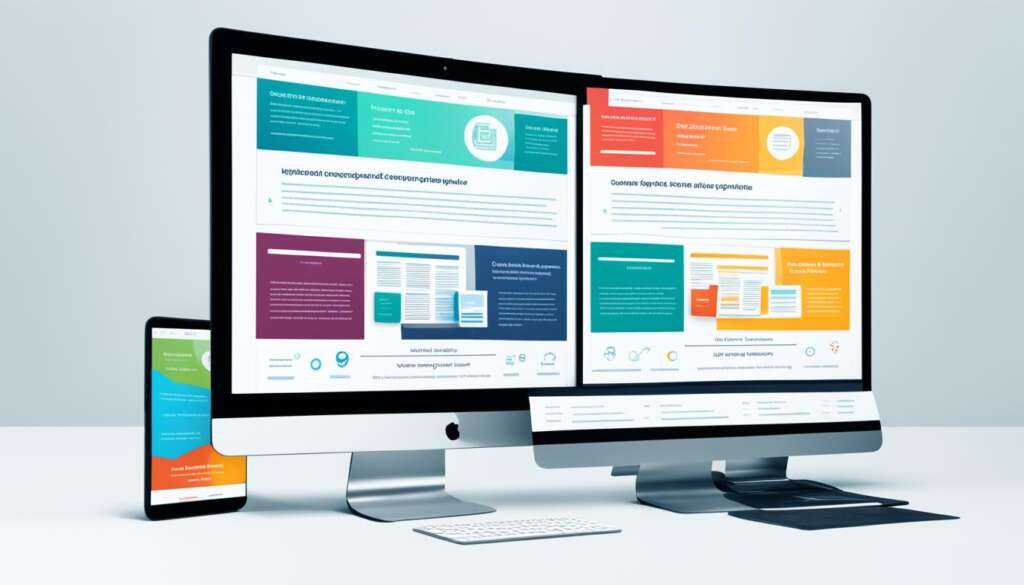Table of Contents
When it comes to web design strategies, two popular approaches have emerged: adaptive design and responsive design. As a UI/UX designer, understanding the differences between these two approaches is essential to create seamless and user-friendly websites.
Adaptive design involves creating multiple fixed layouts for different screen sizes. This means that based on the user’s device, the website serves a specific layout designed explicitly for that screen size. On the other hand, responsive design adjusts the layout dynamically based on the screen size, ensuring that the content remains accessible and visually appealing across different devices.
Each approach has its strengths and weaknesses. Responsive design, with its fluid layout and use of media queries, offers a flexible and optimal display of content on any device. It provides a seamless user experience by automatically adjusting the layout to fit the available space. However, designing responsively requires a deep understanding of user needs and meticulous attention to detail.
Adaptive design, on the other hand, allows designers to create customized experiences for specific devices. By creating fixed layouts for different resolutions, designers have more control over the design elements and can tailor the user experience accordingly. However, adaptive design requires more initial work and may exclude users with uncommon screen sizes.
Choosing between adaptive and responsive design depends on various factors such as the project requirements, user experience goals, workload, and maintenance. While responsive design is easier to implement and maintain, adaptive design offers more creative control. Ultimately, it’s crucial for UI/UX designers to consider these factors and select the approach that best suits the specific needs of each project.
Understanding Responsive Design
Responsive design is an essential aspect of modern web design that aims to provide an optimal user experience across different devices. Coined by Ethan Marcotte in his groundbreaking book, Responsive Web Design, this approach employs a fluid layout and media queries to adapt the website’s appearance based on the available browser space and screen size. By leveraging responsive design techniques, designers can ensure that the content is displayed optimally, regardless of whether the user is accessing the site on a desktop, tablet, or smartphone.
The key to responsive design lies in its fluid layout. Instead of fixed dimensions, the website’s elements adapt and rearrange themselves dynamically to fit the available space. This flexibility enables a seamless browsing experience, eliminating the need for users to constantly zoom in or scroll horizontally to access content. Whether it’s enlarging images, repositioning navigation menus, or adjusting font sizes, responsive design ensures that everything looks visually appealing and remains easily readable on any device.
To achieve this fluid layout, designers rely on media queries. These CSS rules detect the user’s screen size and apply specific styles accordingly. By combining media queries with CSS properties such as max-width and min-width, designers can create breakpoints where the layout adjusts and different design features come into play. For example, a responsive design may have a breakpoint where the navigation menu switches from a horizontal layout to a mobile-friendly hamburger menu when viewed on smaller screens.
Media queries play a crucial role in the implementation of responsive design. They allow designers to tailor the website’s appearance to different devices, ultimately enhancing the user experience. By harnessing the power of media queries, a website can seamlessly transition between different layouts, accommodating a wide range of screen sizes and user preferences.
Optimizing the user experience is at the core of responsive design. By providing a consistent and user-friendly interface across devices, responsive design caters to the needs and expectations of modern users who access websites on various screens. It eliminates the frustration of zooming and scrolling, making information readily accessible, and enhancing overall satisfaction.
However, implementing responsive design requires meticulous planning and an in-depth understanding of end users’ needs and wants. Designers must consider factors such as content prioritization, loading times, touch-friendly elements, and navigational structures to create an intuitive and enjoyable experience. Responsive design is a powerful tool in the hands of skilled designers who strive to deliver exceptional user experiences in today’s multi-device landscape.
Exploring Adaptive Design
Adaptive design, introduced by Aaron Gustafson, is a web design approach that focuses on creating multiple fixed layouts for different screen sizes. Unlike responsive design, which adjusts the layout based on the screen size, adaptive design offers designers more control over the visual experience on various devices. By creating distinct layouts for different resolutions, adaptive design caters to the specific needs of each device, ensuring optimal performance and user experience.
When a website utilizing adaptive design detects the available space on a given device, it selects the most appropriate layout to display. This tailored approach allows designers to create a cohesive user experience that aligns with the capabilities and limitations of each screen size. By optimizing the layout for specific resolutions, adaptive design ensures that content is presented in the most effective and engaging manner.
Although adaptive design requires more initial work compared to responsive design, it offers the benefit of enhanced control over the design on different screen sizes. This control allows designers to fine-tune the user experience and optimize the design elements for each resolution. By providing a consistent and tailored experience across multiple devices, adaptive design contributes to improved user satisfaction and engagement.
While adaptive design is a powerful tool for creating a rich user experience, it also comes with challenges. Designers must consider multiple resolutions and develop fixed layouts for each. This process involves careful planning and development to ensure that the design adapts seamlessly to various resolutions. Additionally, maintaining multiple layouts can be more time-consuming and resource-intensive compared to responsive design.
The key advantage of adaptive design lies in its ability to deliver optimal user experiences, tailored for each resolution.
By utilizing adaptive design, designers can deliver a visually compelling and engaging experience to users across devices. This approach provides greater control over the design on different screen sizes, allowing for a more tailored and impactful user experience.
Choosing Between Adaptive and Responsive Design
When it comes to selecting the right design approach for your website, there are two popular options to consider: responsive design and adaptive design. Each has its own pros and cons, as well as specific design considerations. Let’s take a closer look at both options to help you make an informed decision.
Responsive Design
Responsive design is a flexible and versatile approach that adapts to different screen sizes and resolutions. It uses a fluid layout that automatically adjusts based on the available space, ensuring that the content is displayed optimally on any device. This adaptability makes responsive design a preferred choice for new projects.
Here are some key advantages of responsive design:
- Ease of Implementation: Responsive design is relatively easier to implement compared to adaptive design, making it a quicker and more efficient option.
- Effortless Maintenance: With responsive design, you only need to manage a single codebase, which reduces the effort required for maintenance and updates.
- Support for Infinite Screen Sizes: Responsive design accommodates an infinite number of screen sizes, ensuring a seamless user experience across various devices.
However, responsive design has a few drawbacks to consider:
- Layout Limitations: While responsive design adjusts content layout based on screen size, it may have limitations in controlling the layout on every device. Some elements may not align perfectly on all screen sizes.
- Potential Performance Impact: Due to the need for additional CSS media queries and adaptive styles, responsive design can sometimes result in slower loading times.
Adaptive Design
Adaptive design, on the other hand, involves creating multiple fixed layouts tailored to specific screen sizes. When a website detects the available space, it selects the most appropriate layout. This approach offers more control over the user experience and allows for a high level of customization.
Consider the following advantages of adaptive design:
- Greater Control: Adaptive design provides designers with the ability to finely tune the user experience for each screen size, optimizing performance and delivering a more tailored experience.
- Effective for Retrofitting: Adaptive design is often chosen for retrofitting existing websites, where the goal is to improve usability and experience on specific devices or screen sizes.
However, there are some considerations and limitations associated with adaptive design:
- Increased Workload: With adaptive design, designers need to create and maintain multiple layouts, resulting in increased workload and development time.
- Exclusion of Uncommon Screen Sizes: Since adaptive design focuses on specific screen sizes, it may not provide an optimal experience for users with less common devices or screen dimensions.
Now that you have a better understanding of the pros and cons of responsive and adaptive design, you can make an informed decision based on your project requirements and design considerations.
Table: A Comparison of Responsive and Adaptive Design
| Aspect | Responsive Design | Adaptive Design |
|---|---|---|
| Implementation Complexity | Relatively Easy | More Complex |
| Maintenance Effort | Efficient | Requires More Effort |
| Layout Control | May Have Limitations | Greater Control |
| Performance | Can be Slower to Load | Optimized for Specific Devices |
| Flexibility | Accommodates Infinite Screen Sizes | Customized for Specific Screen Sizes |
Remember that the choice between responsive and adaptive design depends on various factors, including your project goals, user needs, and target devices. While responsive design offers ease of implementation and flexibility, adaptive design provides greater control and customization. Consider these pros and cons, as well as your specific design considerations, to choose the most suitable approach that aligns with your requirements and delivers a seamless user experience.
Conclusion
When it comes to web design strategies, UI/UX designers are faced with a crucial decision: choosing between adaptive and responsive design. Both approaches have their merits and drawbacks, making it essential to carefully consider the specific requirements of the project at hand.
One of the key factors to weigh is user experience. Responsive design ensures that content adapts to different screen sizes and provides a seamless browsing experience. On the other hand, adaptive design allows for greater control over the layout, tailoring the user experience for each device.
Another consideration is the level of control and workload. Responsive design is easier to implement and maintain, accommodating an array of screen sizes effortlessly. Adaptive design, while requiring more upfront work, offers greater control over design elements on different devices.
Ultimately, the choice between adaptive and responsive design boils down to finding the right balance between user experience, layout control, workload, and maintenance. Understanding the nuances of each approach is key to creating modern web designs that meet the diverse needs of users on various devices.
FAQ
What is the difference between adaptive design and responsive design?
Adaptive design involves creating multiple fixed layouts for different screen sizes, while responsive design adjusts the layout based on the screen size and reorganizes content to fit the available space.
How does responsive design work?
Responsive design uses a fluid layout that adjusts based on the available browser space. Media queries are used to determine the screen size and apply appropriate styles.
What are the advantages of responsive design?
Responsive design ensures that content is displayed optimally on different devices, providing a seamless user experience. It accommodates an infinite number of screen sizes and is easier to implement and maintain.
What is adaptive design?
Adaptive design involves creating multiple fixed layouts for different screen sizes. When a website detects the available space, it selects the layout most appropriate for the screen.
What are the advantages of adaptive design?
Adaptive design allows designers to customize the user experience for each device and ensure optimal performance. It offers more control over the design on different screen sizes.
Which design approach is preferred for new projects?
Responsive design is generally preferred for new projects due to its ease of implementation and maintenance.
When is adaptive design used?
Adaptive design is often used for retrofitting existing sites or for specific screen sizes.
What factors should be considered when choosing between adaptive and responsive design?
Factors such as user experience, control over the layout, workload, and maintenance should be carefully considered when choosing between adaptive and responsive design.
What are the drawbacks of responsive design?
Responsive design may have limitations in controlling the layout on every device and it can be slower to load.
What are the drawbacks of adaptive design?
Adaptive design requires more work initially and may exclude users with uncommon screen sizes.













